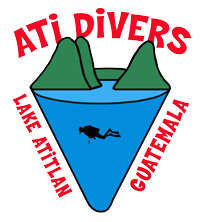
Lake Atitlan is both the deepest and highest altitude (1562m) lake in Central America and one of the most beautiful lakes in the world. “Atitlan” in Mayan means “the place where the rainbow gets its colours”. The lake is situated in an area of Guatemala where a string of volcanoes has formed as the Cocos plate of the Pacific is subducted beneath the Caribbean plate.
150,000 years ago a magmatic batholith (a huge subterranean pocket filled with liquid magma) formed in the area that is now the lake. This was fed by the Los Chocoyos Batholith, which discharged in a massive, violent eruption around 84,000 years ago. The eruptive column reached heights of between 40 to 60km and dispersed ash over an area from Florida to Ecuador. So much magma had been expelled that only an empty cavity remained. Unable to support the weight of the earth above it, the area collapsed, forming the 18km diameter caldera.
Originally 900m deep, the caldera filled over time with rainwater and sediment to create the lake we have today. The caldera is lined with sediment for 300m or so, before being filled with water for another 340m and finally 300m (more or less) of air to the rim of the lake.
What you might see under the water…






